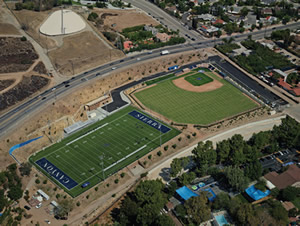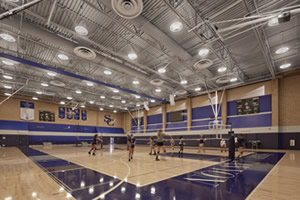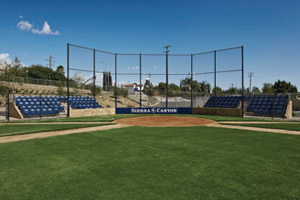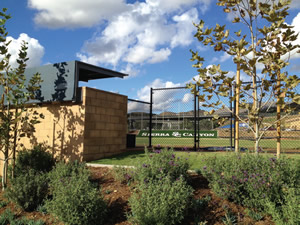Planning Your Sports Facilities
 For over 20 years, Parallax Associates, Architecture and Planning has been working with clients to design sports facilities that meet specific needs and budgets. We have provided planning and design services for both playing fields and gymnasium buildings featuring college-level sports facilities, and our experience has given us a clear picture of what matters most. If you are planning an athletics facility, here are five suggestions to help ensure success.
For over 20 years, Parallax Associates, Architecture and Planning has been working with clients to design sports facilities that meet specific needs and budgets. We have provided planning and design services for both playing fields and gymnasium buildings featuring college-level sports facilities, and our experience has given us a clear picture of what matters most. If you are planning an athletics facility, here are five suggestions to help ensure success.
1. Know Your Facility’s Needs
Before beginning the project’s design phase, meet with athletics staff and user groups to understand how the indoor and/or outdoor facilities will be used. During this step, confirm which sports will be played, which age groups will be playing them, how the spaces will be used for non-athletic activities, such as assemblies, and what kinds of provisions for spectators are needed.
In addition, determine specific requirements such as court and field sizes, sun orientation, storage needs and audio-visual needs. Summarize conclusions resulting from these preliminary meetings in a “project brief” and distribute the brief to participants for approval. This process creates clear objectives for the design team and puts all stakeholders on record. Documenting these needs will help ensure that plans meet the facilities’ goals and minimize expensive design changes later in the process.
 2. Consider the Gymnasium Floor
2. Consider the Gymnasium Floor
If a gymnasium is part of the project’s scope, selecting the right floor system is critical. When evaluating flooring material, consider structural resiliency, surface hardness, surface texture, and ball bounce, as well as safety requirements, budget and aesthetics. Flooring options vary widely, and while hardwood surfaces are traditionally specified, multi-use synthetic surfaces are becoming increasingly popular.
The most common hardwood system for gymnasiums is made of tongue-and-groove maple strips laid over a plywood subfloor set on plywood “sleepers.” This composite system allows the floor to move and “breathe” with changes in play intensity and room humidity. The specific components vary, so meeting with product representatives to understand performance and pricing options is beneficial.
3. Determine your Lighting Priorities — Inside and Out
Over the last decade, artificial lighting has become more energy efficient as compact fluorescent and LED lamps replace less energy-efficient metal halide fixtures. However, light color and lumen output (brightness) must still be considered for a successful strategy. For this reason, we recommend working with a lighting designer to ensure that design goals and local energy codes are met.
Lighting needs for indoor and outdoor venues differ. Large interior spaces, like gymnasiums, need lighting that supports various formats. A basketball game has different requirements than a school assembly. Accommodating alternate uses with appropriate fixtures and controls is critical to making a highly flexible, well-functioning space.
Also, it’s important to consider the potential for natural light sources — skylights and clerestory windows, for example, can provide a sense of connection to the outdoors while supplementing lighting in ways that reduce energy costs.
 Outdoor field lighting presents different challenges. Here, the goal is to provide bright, even illumination over a large area while minimizing glare and light spillage to adjacent properties. Although there are many options, only a few provide the focused light output and shielding needed to meet these goals. Working with a lighting consultant can ensure that you source appropriate products.
Outdoor field lighting presents different challenges. Here, the goal is to provide bright, even illumination over a large area while minimizing glare and light spillage to adjacent properties. Although there are many options, only a few provide the focused light output and shielding needed to meet these goals. Working with a lighting consultant can ensure that you source appropriate products.
4. Select the Right Turf for Playing Fields
When designing playing fields, an important question is: natural or synthetic turf? The answer depends on certain circumstances, such as geographic location, weather patterns and field use frequency. Weighing the pluses and minuses of both will help identify the best solution; below is a partial list:
| Natural Turf |
| Pluses: |
Minuses: |
- Traditional appearance
- Cool/stable surface temperature
- Rainwater percolates directly to subsurface soil
- Easy to stripe and re-stripe
- No heat-island effect
|
- Needs to “rest” and regenerate after seasons
- Requires year-round irrigation
- In-season wear zones are common
- Requires constant maintenance
|
| Artificial Turf |
| Pluses: |
Minuses: |
- Reduced water requirements
- Maintains appearance all year long
- Reduced maintenance requirements
- Provides high surface uniformity
|
- Increased surface temperature variation
- Heat-island effect radiates heat energy back into atmosphere
|
Although artificial fields are somewhat easier to maintain, both require significant maintenance. Natural grass needs regular watering, mowing, reseeding and pest control. Artificial turf requires brushing, cleaning, pest control and will eventually need to be mended or replaced.
Field lines are another consideration. Oftentimes, they are sewn directly into the artificial turf fibers making it a challenge to alter the striping for multi-use fields. Natural turf on the other hand, can be easily re-striped to accommodate different sport formats.
 Finally, certain filler products used in artificial turf have raised concerns about health risks. Since there are several artificial turf systems on the market, it is important to compare them, visit existing installations, and get a clear understanding of each system’s components, look and feel.
Finally, certain filler products used in artificial turf have raised concerns about health risks. Since there are several artificial turf systems on the market, it is important to compare them, visit existing installations, and get a clear understanding of each system’s components, look and feel.
5. Consider Outdoor Comfort
In some regions, spring and summer can bring high temperatures, creating exhausting conditions for outdoor play. To help athletes stay cool while off the field, shaded dugouts or other screened structures can provide relief. Shade trees planted along the field’s perimeter are an elegant way of providing shelter from the sun.
Designing successful sports facilities is a layered, collaborative process. Whether you are renovating existing facilities or constructing new ones, these five suggestions are just a few ways to help you create a high-functioning design that maximizes return on investment and produces winning results.
This article originally appeared in the issue of .